

Sew-along with us!
Perhaps you'd like some company while you sew? We've sewn up each of our patterns and photographed each step along the way. Find the pattern you're after in the filter drop down below left.
Sew-Alongs
Haslam Hat Sew-Along: Day 1 - Choosing Fabric and Accents
Inspiration:

Our inspiration for the Haslam Hat was providing our sewing community with a straightforward, simple-to-construct, and easily customizable, winter hat.
No matter which version you make or what features you wish to include, the total sewing time for the Haslam Hat is just a couple of hours! This quick project is perfect for last-minute gifts or for making matching sets for friends and family.
Our instructions include step-by-step instructions on creating an optional pom-pom or tassel for the top of your hat and how to add ties. You don't need anything fancy to make these accents, but if you wish we recommend the Purl Soho Pom-Pom Making kit. Here are examples of other tools you may find at your local craft store:

You can also cut a piece of cardboard or simply use your HAND to make a pom-pom or tassel too!

Fabric:
We recommend using a medium-weight sweater knit fabric such as sweatshirt fleece, lofty French terry, or flannel with a slight stretch to make the Haslam Hat. For the lining of the hat, we recommend experimenting by using the wrong side of the fabric right side out for extra coziness and warmth on cold days.
Using contrast print fabrics could add some fun and unique details to your hat as well. For example, using a different print or color for the top of the hat vs the hem band or ear flaps vs the lining.
You can also repurpose a ready-made sweater to make a Haslam Hat! See our next blog post on how to do that.

Haslam Hat Sew-Along: Day 2 - Repurposing a Ready Made Sweater
Sewing the Haslam Hat Variation 1 with a Pom-Pom
Do you have a sweater sitting in your closet that you don't wear anymore or found one thrifting that you might not wear but loved the texture or color of the fabric? Not sure what to do with it? You can use it to make a Haslam Hat! Here I will demonstrate how you can repurpose a ready-made sweater for your project.

Here is a vintage sweater that stood out to me as a great candidate for repurposing. The various grey shades, chevron design, and red accent could be reworked to create a unique hat. However, it did take some time to figure out exactly which parts of the sweater to use and how.
To begin, I arranged the various pattern pieces throughout the sweater to see where I could cut to get the most out of the fabric.

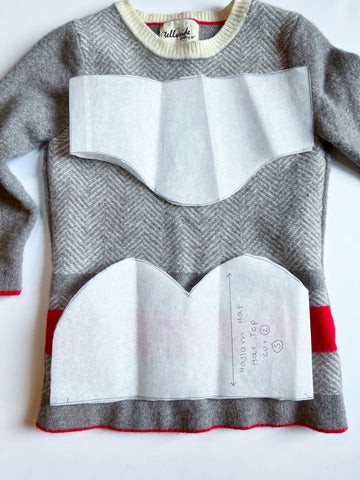
I realized at this point it would be inevitable to piece together parts of the sweater to get full-length pattern pieces. So, I folded the sweater along the center front and back to see where the side seam of the sweater would end up.

Next, I decided to pair polar fleece fabric with the sweater for an extra pop of color.

Using the pattern pieces again, I experimented with placement for how the finished design would look.

Once I had a solid plan, it was time to cut into the sweater!

The result of cutting into the sweater was a success! Utilizing the full width of the center front I could use the red stripe for the hat top. Due to the shape of the sweater, I was not able to get a full-length hem band piece out of the chevron design, so I added some seams which would align with the seams on the hat top. For the lining, I used some super soft polar fleece in grey and dark blue for contrast.

Time to start sewing!
Take the outer hat top piece and place it with the fabric right side up on your workspace.
Fold one outer dome section of the hat top towards the center with the right sides together. Match the first two sets of points together and the curved V-cut out.
Stitch along the curved edges at 5/8" (1.5 cm), creating a curved dart. Press the seam allowances to one side.

Repeat for the opposite side of the hat top, leaving the center unsewn for now.

Open up the hat along the seams and position the hat top so that the two dart seams meet, and the raw edges of the center of the hat top are aligned. Stitch along the curved seams at 5/8" (1.5 cm).

Side view:

View from the finished top:

Turn the hat top right side out.
At this point, try on the hat top and see how it fits around the crown of your head. If you wish for a more fitted look you can extend the dart points to be longer and curve down further on the hat top.

Next, it was time to piece together the fabric scraps to make a full hem band piece.
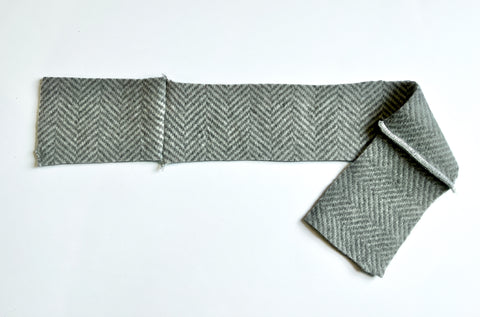
Now we have the outer shell of the hat top and hem band complete.

With right sides together, notches and seams aligned, stitch the hat top to the hem band at 5/8" (1.5 cm).

Repeat all the same steps to create the hat lining.

Turn the hat top shell wrong side out and keep the hat top lining right side out. Match the raw edges of the shell to the lining so that the right sides of the fabric are together and the seams are aligned. Stitch around the edges at 5/8" (1.5 cm). Leave a gap near the back seam about 3" – 4" (8 cm – 10 cm) wide.

Pull the shell and lining through the seam opening so that both the shell and lining are right side out.
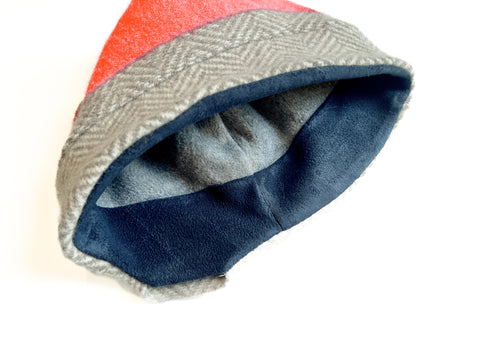
Press the bottom edges of the hat in place. Using a needle and thread, hand sew the opening closed.

With seams aligned stitch in the ditch, through the shell and lining layers, along the seam connecting the hem bands to the hat tops.
For extra reinforcement or decorative finishing, topstitch around the edges of the hem band and on the hat top.

How to make a Pom-Pom:
If you are using a pom-pom maker, follow the manufacturer's instructions to make your pom-pom. If you do not have a pom-pom maker follow the steps to create a pom-pom.
Cut a piece of cardboard as shown in the diagram. You can either create a C-shape (shown in the Haslam instruction booklet) or a rectangle shape (demonstrated here) out of cardboard. Keep in mind the width of your cardboard cut-out will determine how big your pom-pom is.

Wrap yarn around your template. The more yarn you have around the template will determine how fluffy your pom-pom will be. If you want a looser pom-pom wrap less yarn.

Once you're done wrapping the yarn, trim the tail. Next cut a long piece of twine or similar strength string.
TIP: You can use yarn for this part, however, twine or a similarly strong, thin thread is ideal as it will not break or come apart as easily. Twine will also blend into the pom-pom better and will be easier to sew with in later steps.
Wrap the string around the middle of the yarn bundle.
Take your scissors and slide one blade between the outer cardboard edge and the yarn. Carefully cut through the yarn creating a bundle. Tie the string around the middle of the bundle tightly to secure the cut yarns.

Pull the yarn off the cardboard.

Fluff out the yarn so it becomes a pom-pom. Trim around the pom-pom to even out the strands of yarn, but do not cut the string tails as you'll use those to attach the pom-pom to the hat.

One at a time, using a darning needle, thread the string tails through the center top of the hat. Tie and knot the strings together on the lining side of the hat to secure the pom-pom.

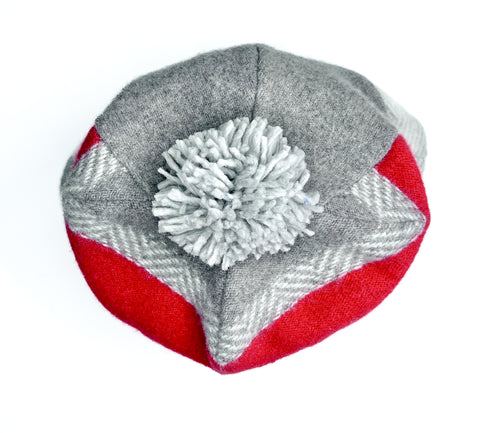

Haslam Hat Sew-Along: Day 3 - Sewing!
Sewing the Haslam Hat Variation 2 with Ties
1. Cut out shell and lining pieces for the hat top and ear flaps.

2. Take the outer hat top piece and place it with the fabric right side up on your workspace.
Fold one outer dome section of the hat top towards the center with the right sides together. Match the first two sets of points together and the curved V-cut out.
Stitch along the curved edges at 5/8" (1.5 cm), creating a curved dart. Press the seam allowances to one side.

3. Repeat for the opposite side of the hat top, leaving the center unsewn for now.
Open up the hat along the seams and position the hat top so that the two dart seams meet, and the raw edges of the center of the hat top are aligned. Stitch along the curved seams at 5/8" (1.5 cm).
Repeat steps 1 - 3 for the hat top lining.

Top View

Side View

Finished Top View
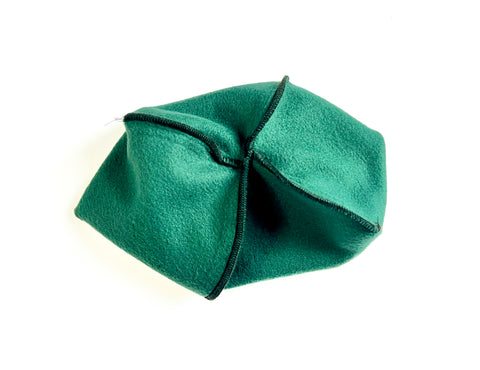
Turn the hat top right side out.
At this point, try on the hat top and see how it fits around the crown of your head. If you wish for a more fitted look you can extend the dart points to be longer and curve down further on the hat top.
4. With the right sides together, fold the shell and lining ear flap pieces in half aligning the short edges. Stitch together at 5/8" (1.5 cm).


5. Cut two long strips of fabric for ties. For this design, I decided to cut strips of green polar fleece used for the hat top. Due to the structure of polar fleece, it does not unravel easily, so you don't have to finish the long edges!

To make the strips look less like rectangles, I stretched the strips lengthwise. This makes the long edges curl in and create more of a tubular shape and look less flat.

6. At the ends of the ties, I made a knot and then clipped into the fabric to create the appearance of tassels.

7. With right sides together, match the shell and lining ear flaps to the hat tops, aligning notches and back seams. Stitch together at 5/8" (1.5 cm).
You now have the shell, lining, and ties for the hat.

8. Match the short ends of the ties to the center bottom of the shell ear flaps. Position the ties so that the raw edge of the ties aligns with the raw edges of the ear flaps and the tassel part goes towards the hat top.

9. Leave the shell and ties with the fabric right sides out, and turn the lining to be wrong side out. Insert the shell into the lining so that the right sides of the shell and lining are matching. Align the shell and lining pieces along the ear flaps, making sure the center back seams are aligned, sandwiching the ties. Stitch together at 5/8" (1.5 cm), but leave a gap near the back seam about 3" – 4" (8 cm – 10 cm) wide.

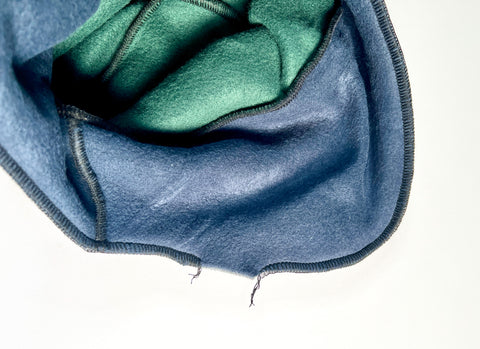
10. Pull the shell and lining through the seam opening to turn the fabric right sides out.

11. Neatly press the edges of the ear flaps in place. Pull on the ties to make sure the shell and lining are turned fully right side out and to create a nice curve.


12. Using a needle and thread, hand-sew the seam opening closed.

13. With seams aligned stitch in the ditch, through the shell and lining layers, along the seam connecting the ear flaps to the hat tops.
For extra reinforcement or decorative finishing, topstitch around the edges of the ear flaps and on the hat top.








